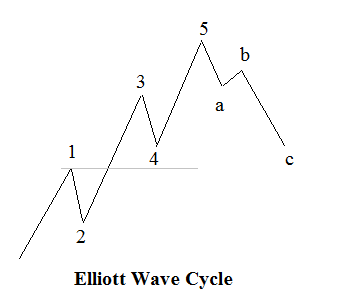Elliott
Wave Theory Basics Explained
Learn Elliott Wave Theory Basics
|
Elliott
Wave Theory Basics Explained
When
investors and
traders first discover, and have Elliott
Wave theory basics
explained
to them, there are various
reactions:
-
Disbelief - that
market movements can follow patterns and are often predictable by
technical analysis methods
-
Joyous irrational
exuberance - at having found the holy grail, a crystal ball to
foretell the future
-
And
finally the correct,
and useful response - here
is a valuable new tool that I
should learn how to use.
Just like
any
system
or structure found in the natural world, the closer you look at its
wave patterns, the
more structured complexity you see. It is structured,
because natures patterns build on themselves,
creating similar forms
at progressively larger sizes. You can see these fractal patterns in
botany, geography, physiology, and the things humans create, like
roads, residential subdivisions and - as recent discoveries have
confirmed - in market prices.
Natural
systems,
including Elliott wave
patterns in stock market charts, evolve
through
time,
and their forms are defined by interruptions to that growth.
Here's
what we mean by that. When your hands are first formed in the womb,
they look like round paddles growing equally in all directions.
Then, in the places between your fingers, cells ceased growing
or died off, and growth was directed to the five digits. This
structured
progress and regress is essential to all forms of growth.
The fact that this
punctuated growth appears in market data is only natural -
as Robert Prechter, Jr., the world's best known Elliot wave
expert and president of Elliott
Wave
International,
says, Everything
that thrives must have setbacks.
Learn
Elliott Wave Theory Basics
We
have all heard the phrase 'one step forward and two steps back' to
describe a situation where we feel as though we are going nowhere, or
achieving nothing.
R.N. Elliott's observations were that
as the market progresses, prices
tend to ebb and flow in wave like
moves. Impulsive, flowing moves would consist of 5 waves
followed by an
ebbing back, in a more corrective period where prices seem to struggle
to get anywhere, and consisting of 3 waves.
Each wave then
develops within part of a larger cycle. The complete cycle is composed
by those 2 parts and each cycle is part of an ever expanding matrix of
interlinking cycles of various degrees of trend.
|
In the basic Elliott wave
formation,
impulsive waves are labelled with
the
numbers 1,2,3,4,5, and corrective waves are labelled
with the letters
a,b,c.
As we can see in the chart above, impulsive waves will gain
a lot of ground whereas in corrective waves, prices tend to struggle to
get anywhere. Corrective waves are more of a sideways consolidation or
range bound move that occurs when the market wants to hold on the
ground that has been gained.
It is important to remember that
these charts are showing 5 waves up and 3 waves down as in a positive
market, but impulsive
waves also occur when markets are declining.
An
impulsive move in a declining market will take the form of 5 waves down
and 3 waves up.
|
Impulse Waves
Impulse
waves are powerful moves composed
of 5 sub waves that drive the market in the direction of
the larger
trend. Within the larger impulse wave, the 5 waves subdivide into
5,3,5,3,5
formations and are labelled 1,2,3,4,5.
Waves 1,3 and 5 are the impulse
waves and are powerful, driving moves which are interrupted by the
waves 2 and 4 corrective and consolidating phases, creating the wave
like structure.
- The
smart money enters the market - The trend has changed but
the market remains uncertain.
- Retraces some of the first wave
back testing the previous extreme - the initial burst has petered out
but the market does not
seem to to have enough energy to resume the previous trend.
- Mass
participation causes prices to explode in the direction of
the new trend as the market accepts that the trend has
reversed.
- Quite often a shallow retrace of
the Third wave as the
market consolidates its gain and investors start taking
profits.
- Distribution
phase - Profit taking increases as the last man standing is forced into
accepting that the trend has changed and is forced to liquidate his
positions - Capitulation!
An impulse wave
itself always sub
divides into 5 waves to a lesser degree, so the important factor for an
Elliott Wave analyst in recognising that the trend has reversed is to
be able to count 5 waves in the internal sub divisions of the move.
Wave
construction is always the most important factor in wave recognition so
let's look at the subdivisions within an impulse wave.
Wave 1 (Impulse)
First
waves subdivide into 5 smaller waves and can be either slow but steady,
grinding away and relentlessly moving against the trader convinced the
previous trend is still underway, or they can be sharp and decisive
blowing those traders out of the water.
First waves can also
take the form of a Leading Diagonal which involves an overlap of waves
2 and 4 but these must still subdivide into 5,3,5,3,5
formation.
Wave 2 (Corrective)
Second waves subdivide into 3 smaller waves and are often sharp and
deep, retracing much of the wave 1.
Many
traders are still convinced that the previous trend is still in effect.
Generally speaking, second waves will be very deep and are most likely
to retrace much of the first wave if that was a slow grinding move.
Very sharp and powerful first waves can lead to a very shallow wave 2.
It is very important to remember that wave
2s never retrace more than 100% of wave 1. If prices move
beyond the
origin of wave 1, it is a clear signal to the Elliott Wave analyst that
his analysis is wrong.
Wave 3 (Impulse)
Third
waves subdivide into 5 smaller waves and are usually the largest and
most powerful. These waves are on high volume and are
broad ranging
with mass participation as the new trend becomes clear.
Wave
3s are never the shortest impulse wave and are most
likely to extend.
Wave 4 (Corrective)
Fourth
waves subdivide into 3 smaller waves. Elliott Fourth waves are often
very complex moves
and tend to be sideways and range bound moves frustrating bulls and
bears.
Wave 5 (Impulse)
Fifth waves
subdivide into 5 smaller waves and are distribution phases. These
usually display a
weakening of the trend in prices,
breadth and on
volume. They can be long and drawn out as the market 'tops' or
'bottoms' but at times they can be very sharp 'spike' like
moves.
Fifth
waves can take the form of and Ending
Diagonal and involves the overlap
of waves 2 and 4 but the differ from a Leading Diagonal which can
appear in the wave 1 position, in that they subdivide into a 3,3,3,3,3
construction.
Corrective waves
Corrective Elliott waves
retrace part of the previous
trend......Corrective
Waves |
|
|
|